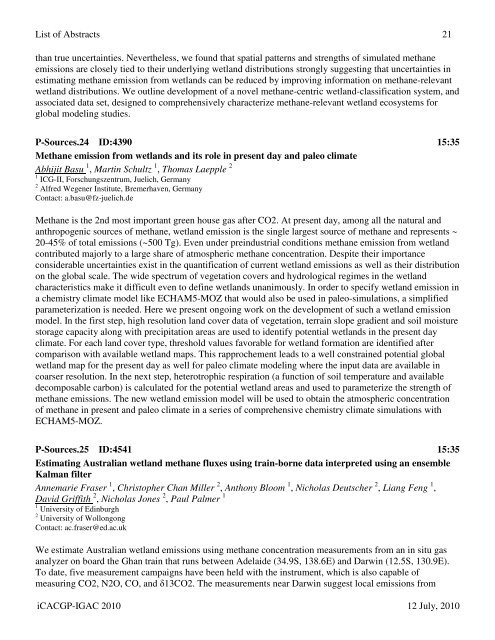Download Abstracts Here - IGAC Project
Download Abstracts Here - IGAC Project
Download Abstracts Here - IGAC Project
Create successful ePaper yourself
Turn your PDF publications into a flip-book with our unique Google optimized e-Paper software.
List of <strong>Abstracts</strong> 21than true uncertainties. Nevertheless, we found that spatial patterns and strengths of simulated methaneemissions are closely tied to their underlying wetland distributions strongly suggesting that uncertainties inestimating methane emission from wetlands can be reduced by improving information on methane-relevantwetland distributions. We outline development of a novel methane-centric wetland-classification system, andassociated data set, designed to comprehensively characterize methane-relevant wetland ecosystems forglobal modeling studies.P-Sources.24 ID:4390 15:35Methane emission from wetlands and its role in present day and paleo climateAbhijit Basu 1 , Martin Schultz 1 , Thomas Laepple 21 ICG-II, Forschungszentrum, Juelich, Germany2 Alfred Wegener Institute, Bremerhaven, GermanyContact: a.basu@fz-juelich.deMethane is the 2nd most important green house gas after CO2. At present day, among all the natural andanthropogenic sources of methane, wetland emission is the single largest source of methane and represents ~20-45% of total emissions (~500 Tg). Even under preindustrial conditions methane emission from wetlandcontributed majorly to a large share of atmospheric methane concentration. Despite their importanceconsiderable uncertainties exist in the quantification of current wetland emissions as well as their distributionon the global scale. The wide spectrum of vegetation covers and hydrological regimes in the wetlandcharacteristics make it difficult even to define wetlands unanimously. In order to specify wetland emission ina chemistry climate model like ECHAM5-MOZ that would also be used in paleo-simulations, a simplifiedparameterization is needed. <strong>Here</strong> we present ongoing work on the development of such a wetland emissionmodel. In the first step, high resolution land cover data of vegetation, terrain slope gradient and soil moisturestorage capacity along with precipitation areas are used to identify potential wetlands in the present dayclimate. For each land cover type, threshold values favorable for wetland formation are identified aftercomparison with available wetland maps. This rapprochement leads to a well constrained potential globalwetland map for the present day as well for paleo climate modeling where the input data are available incoarser resolution. In the next step, heterotrophic respiration (a function of soil temperature and availabledecomposable carbon) is calculated for the potential wetland areas and used to parameterize the strength ofmethane emissions. The new wetland emission model will be used to obtain the atmospheric concentrationof methane in present and paleo climate in a series of comprehensive chemistry climate simulations withECHAM5-MOZ.P-Sources.25 ID:4541 15:35Estimating Australian wetland methane fluxes using train-borne data interpreted using an ensembleKalman filterAnnemarie Fraser 1 , Christopher Chan Miller 2 , Anthony Bloom 1 , Nicholas Deutscher 2 , Liang Feng 1 ,David Griffith 2 , Nicholas Jones 2 , Paul Palmer 11 University of Edinburgh2 University of WollongongContact: ac.fraser@ed.ac.ukWe estimate Australian wetland emissions using methane concentration measurements from an in situ gasanalyzer on board the Ghan train that runs between Adelaide (34.9S, 138.6E) and Darwin (12.5S, 130.9E).To date, five measurement campaigns have been held with the instrument, which is also capable ofmeasuring CO2, N2O, CO, and δ13CO2. The measurements near Darwin suggest local emissions fromiCACGP-<strong>IGAC</strong> 2010 12 July, 2010








